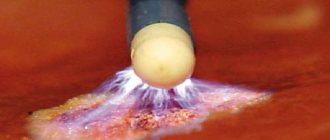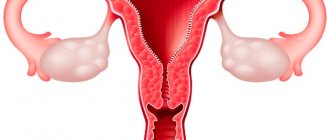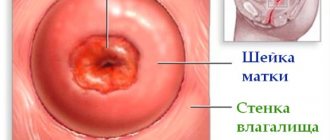Almost all diseases that are associated with a woman’s reproductive system occur at an initial stage without symptoms. Most often, a girl learns about the disease during a routine examination with a gynecologist.
However, an advanced form of cervical pathology can lead to serious health complications. Often erosion and other inflammatory processes lead to the formation of tumors.
For this reason, it is necessary to closely monitor your health and visit a doctor more often for preventive purposes. If cervical erosion is detected, the method of therapy depends on several factors.
These are the age characteristics of the patient, the desire to preserve the reproductive system, as well as the nature of the course of the disease.
On what days of the menstrual cycle should you cauterize erosion?
Today, gynecologists offer several options for treating erosion. The best time in each specific case is selected based on the duration and abundance of the patient’s menstruation. With normal heavy menstruation, the procedure is prescribed on the 3rd day, and with long periods - on the 6th. There are several reasons why doctors recommend moxibustion on days 3-6 of the menstrual cycle. This:
- The healing speed of the scab that appears at the site of the intervention is about a month. Thus, before the onset of menstruation, the epithelium is completely restored, menstrual blood does not come into contact with the healing wound and does not provoke the development of inflammation.
- The cervix remains slightly open these days. This allows the gynecologist to see the entire affected area and carry out cauterization as accurately and effectively as possible in the first days of the cycle.
Is it possible to cauterize erosion on other days of the cycle?
In some cases, cervical erosion is cauterized before menstruation. This technique is common in the treatment of ectopia using radio wave and laser equipment. Despite the fact that the risk of inflammation with this method of treatment is minimal, if erosion is cauterized before menstruation, there is a possibility of negative consequences. This is a delay in menstruation, the development of genital endometriosis. It is more difficult for a woman to control the nature of the discharge that occurs during the healing process after the cauterization procedure.
You can cauterize cervical erosion after menstruation, if the gynecologist recommends it based on the patient’s tests. For example, when a patient is recommended for cryotherapy, it would be correct to carry out the procedure only a week after the end of menstruation.
ATTENTION! In the first days of menstruation, it is not advisable to cauterize erosion. The gynecologist will not be able to see the whole picture of the lesion due to menstrual blood. This may result in cauterization having to be repeated.
Diagnosis of erosion
A woman often finds out about erosion during a standard visit to the gynecologist. The doctor sees a violation during examination and prescribes the necessary tests. Symptoms of the disease may be absent or mild. Among the main signs indicating a violation of the cervical epithelium are discharge (whitish, cloudy mucous, yellowish or bloody). They can occur during heavy lifting, sexual intercourse, and are accompanied by itching, pain and pain. Menstruation with cervical erosion can change its character - become scanty, heavy, prolonged.
When diagnosing erosion, the doctor makes a conclusion about the size and shape of the epithelial lesion, the reasons why tissue changes could occur and makes a decision on further treatment. The nature of medical care may vary. If abroad erosion is often not cauterized, preferring soft wound healing therapy, then in our country it is customary to take radical measures to eliminate possible complications.
The doctor may decide to delay cauterization, for example, if erosion is diagnosed in a nulliparous patient. After childbirth, shallow erosion may disappear on its own. If the problem remains, it will be eliminated a few months (3-6) after the birth of the baby.
In what cases should you postpone cauterization?
Pregnancy is not the best time to cauterize erosion. The gynecologist’s task is to prescribe healing and anti-inflammatory drugs, as well as dynamic monitoring of the patient’s cervix. Often after pregnancy, erosion disappears without a trace. There are other reasons why conservative treatment should be limited. Moreover, most often efforts are directed precisely at their elimination. Among the diseases that need to be cured before cauterization are the following:
- Candidal colpitis (thrush). Thrush in the acute or chronic stage is treated with antifungal drugs until the problem is completely eliminated, and only then the erosion is cauterized.
- Vaginitis (bacterial and non-bacterial). The doctor prescribes a treatment regimen that relieves inflammation from the vaginal mucosa, and then decides on the advisability of cauterizing the erosion.
- If HPV (human papillomavirus) is detected, it is necessary to raise immunity to an optimal level, and only then begin treatment for disorders of the cervical epithelium.
- The cauterization procedure cannot be prescribed for endometriosis.
Uterine fibroids are not a contraindication for cauterization of erosion. If necessary, with diagnosed fibroids, the doctor selects the most gentle method to eliminate the affected cells. Congenital erosion of the cervix, which often goes away on its own, is usually not cauterized. It is enough to be regularly observed by a specialist and promptly treat concomitant diseases.
When to cauterize
Currently, experts do not always recommend cauterizing an erosive lesion. In some cases, the doctor recommends a wait-and-see approach - the pathology is simply monitored, in others drug treatment is recommended, or even treatment with traditional methods, but sometimes there are absolute indications for cauterizing erosion.
Cauterization is necessary when:
- large amounts of erosion;
- development of ectropion after childbirth;
- frequent relapses of pathology;
- leukoplakia;
- ectopia with scar deformation;
- complication of erosion by endometriosis;
- precancerous cellular changes.
Read more about when you need to cauterize erosion here.
Do not cauterize erosion when:
- colpitis;
- cervicitis;
- chronic infections that are sexually transmitted;
- presence of papilloma virus - first a course of special therapy is required.
Before treating erosion with surgical methods, it is necessary to eliminate the listed ailments.
Methods of cauterization of erosion
If conservative treatment does not bring the desired results, the gynecologist, after a biopsy (tissue sampling from the pathological area of the cervix), prescribes a cauterization procedure. The method must be selected based on the size of the erosion, its type and the cause of its occurrence. Today, several options for effective means of removing altered epithelial cells are used. This:
- Diathermocoagulation is often recommended for nulliparous patients, as well as women who are not planning a pregnancy in the next year. The current causes the uterus to contract, as if contractions were occurring. It's painful enough. A scar forms at the site of the intervention. The woman feels discomfort for some time after the procedure. For about a month, copious transparent discharge is observed, and pain in the lumbar region may begin. Sometimes the erosion is cauterized again. Such side effects have led to the fact that this method is used less and less.
- Cryotherapy is a method of freezing epithelial tissue using nitrogen. The procedure has proven itself well, as it lasts about 10 minutes and does not leave scars or damage to surrounding tissues. The method is painful, which distinguishes it favorably from diathermocoagulation, but it can threaten relapses of the disease, and is not used in cases of deep erosion.
- Gentle methods include radio wave exposure. Electromagnetic vibrations effectively stimulate cells, causing the affected areas to break down. This procedure is recommended for nulliparous women and women planning pregnancy in the near future. Before the procedure is performed, the patient is prepared. You should follow a diet for several days and take medications prescribed by your doctor before cauterization. The consequences of the intervention are bloody discharge for a week.
- The most modern method is laser therapy. An argon or ruby laser provides a targeted effect on erosion. The possibility of recurrence of cervical erosion with this treatment is minimal, and the healing rate is maximum. But this method is not advisable to use for nulliparous women.
Preparing for the procedure at the antenatal clinic
Under no circumstances should you neglect preparation for the cauterization procedure.
Tests are done first:
- vaginal smear;
- bacterial culture;
- tissue biopsy;
- blood test for infections;
- blood chemistry;
- analysis for tumor markers;
- PCR.
Analyzes must be fresh . A number of diagnostic procedures are also prescribed: it is necessary to ensure that there is no pregnancy; if pathology is suspected, an ultrasound scan may be prescribed. Colposcopy and external examination can reveal visible abnormalities.
During the preparation period for a week, it is recommended not to overeat and avoid food with dyes and preservatives. The procedure itself is carried out on an empty stomach. 2-3 days before cauterization, you should avoid intimate contact. For two weeks, you must stop using tampons, douching, and anything else that can further injure the mucous membrane. Avoid taking blood thinners.
Recovery period after cauterization of erosion
It will not be possible to do cauterization and immediately forget about the problem. It is necessary to prepare for the fact that the recovery period will bring some restrictions and discomfort. Sex and heavy lifting are taboo until complete healing. Sexual contact can lead to tissue injury, and heaviness can lead to tension in the uterus and, as a result, bleeding. You cannot take hot baths or go to the sauna. Swimming in the pool and sunbathing on the beach is possible only after the permission of the attending physician.
The nature and abundance of discharge that occurs after cauterization depends on the size of the erosion that had to be removed, the method of cauterization and the anatomical characteristics of the patient. For some women it’s a week of spotting and irregular discharge, for others it’s 3 weeks of fairly heavy discharge.
The menstrual cycle resumes after a month. In some cases, the first time before menstruation, uncharacteristic pain and discharge are noted. It is necessary to regularly visit a gynecologist to prevent relapse of the disease and monitor the healing process.
How does the treatment process work?
Diathermocoagulation
The oldest method of treatment. Cauterization is carried out with high-frequency electric current. One electrode is inserted into the vagina, the second is placed under the patient’s back. The large amount of heat generated melts the affected area. The procedure takes about half an hour, its effectiveness is 75% .
Women who have undergone diathermocoagulation note that it is painful. Recovery of the female body takes from 7 to 10 weeks.
- infertility;
- heavy bleeding;
- endometriosis.
In this regard, a woman who has undergone a diathermocoagulation procedure should regularly visit a gynecologist. At first, sexual intercourse and heavy lifting are contraindicated.
Antibacterial ointments will help speed up healing . Discharge and lower back pain may occur for a month after the procedure.
The diathermocoagulation procedure is contraindicated:
- pregnant women;
- women in the postpartum period;
- affected by infectious diseases or malignant tumors of the uterus.
Diathermoexcision
As in the previous method, one electrode is placed under the back. The doctor monitors the process using a gynecological speculum, and uses a colposcope to determine the affected area. The erosion is treated with iodine so that the boundaries of the lesion are better visible . Local anesthesia is administered using a long needle. The diameter of the electrode is selected in such a way as to capture the entire erosion zone at once.
Unlike the previous method, the affected tissue is not simply cauterized, but removed. She is then sent for research. The duration of the procedure is up to half an hour.
Preparation for the procedure is similar to preparation for diathermocoagulation. The procedure is quite painful and takes about thirty minutes.
Recovery of the body occurs within 1-2 months . After about a week, the crust that forms on the affected area comes off. After this, bleeding may occur. For productive recovery, you should exclude:
- sex life;
- bath;
- do not take a bath;
- do not lift heavy objects;
- do not swim in open waters.
Possible pain in the lower abdomen. This is one of the most traumatic methods of treating erosion and can lead to scars, bleeding, and hematomas. In 25% of cases, relapse is possible.
Radio wave methods
A free electrode is placed under the patient's lower back. The procedure is carried out using mirrors. The doctor selects the electrode size depending on the size of the lesion . The nature of the erosion determines whether it will be cauterized or removed along with the affected tissue.
The electrode does not directly interact with the cervix. The effect is produced using high-frequency radio waves, which cause tissue heating and diseased cells seem to evaporate. At the same time, the surface on which the electrode acts is sterilized.
The method is non-contact and does not cause discomfort. Unlike previous methods, radio waves do not leave scars, which makes it possible to treat even nulliparous patients. There are no side effects or pain.
In the first days after the procedure you should:
- avoid overheating;
- sexual intercourse;
- physical activity;
- do not use tampons.
Laser vaporization
Laser cauterization is carried out in an outpatient setting : quite quickly, bloodlessly and does not cause complications. As with other methods, laser vaporization requires preparation. During the treatment process, the doctor inserts the laser tip into the patient’s vagina and directs the beam to the affected areas, while the diseased cells evaporate and the capillaries are sealed, which eliminates bleeding.
The specialist must have extensive experience, perform manipulations very accurately and not harm healthy tissue. Recovery after vaporization occurs quite quickly - within 4-6 weeks. At first, there may be some bleeding - this is normal. You should abstain from sexual intercourse and not use tampons for a month. Relapses when using this method occur in approximately 10% of cases.
Cryodestruction
Cauterization is carried out using liquid nitrogen. This method is not as traumatic as surgery, but more effective than drug treatment. Exposure to cold destroys the affected areas and causes them to be rejected. The cryodestructor, touching the affected area, cools the tissue to -200 degrees, causing tissue necrosis. In the future, dead tissue comes out naturally.









